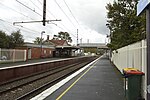Mother of God Primary School
Mother of God Primary School (nicknamed "MOG") was a primary school in Ivanhoe East, Victoria. The school opened in 1963 after being converted from an old house. In the schools infancy the Sisters of St. Joseph of the Apparition taught grades prep to grade 3. With extensions to the school in 1964, it allowed grades 4 and 5 to accepted and then grade 6 students later on.In August 2017, Catholic Education Melbourne confirmed that a review was being undertaken to determine the viability of schools in the Ivanhoe Parish which consisted of three schools, Mary Immaculate School and St Bernadette's School, which are still open and Mother of God. Following the review, the school closed at the end of 2017 with the reasons being "limited enrolment growth" and the need for the Ivanhoe parish to consolidate their resources. In 2016 the school had 106 students enrolled.The site of the school is now leased as the middle school for years 2 and 3 for the neighbouring Ivanhoe East Primary School.
Excerpt from the Wikipedia article Mother of God Primary School (License: CC BY-SA 3.0, Authors).Mother of God Primary School
Warncliffe Road, Melbourne Ivanhoe East
Geographical coordinates (GPS) Address Website Nearby Places Show on map
Geographical coordinates (GPS)
| Latitude | Longitude |
|---|---|
| N -37.773448 ° | E 145.058631 ° |
Address
Ivanhoe East Primary School
Warncliffe Road 35
3079 Melbourne, Ivanhoe East
Victoria, Australia
Open on Google Maps







